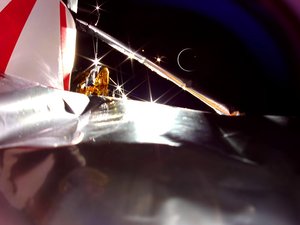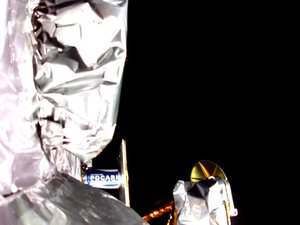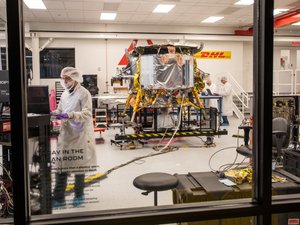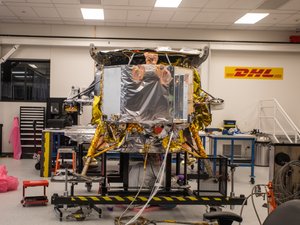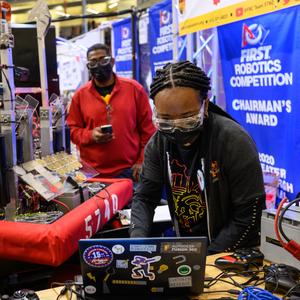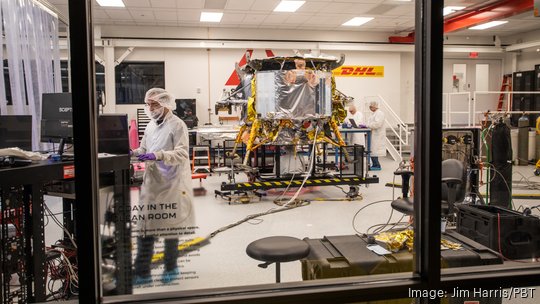
The final resting point for Peregrine, a lunar lander made by Pittsburgh-based Astrobotic Technology Inc., has been identified.
Toward the end of an hour-long media call with reporters to discuss the successes and pitfalls of Peregrine's maiden voyage to the moon, Astrobotic CEO John Thornton announced that the company received confirmation from one of its space-related peers that trace remains of Peregrine had been located near where it was expected to make impact with the ocean in the South Pacific.
Up until this point, Astrobotic, NASA and others presumed Peregrine completed its re-entry around 4 p.m. on Thursday after Astrobotic lost telemetry and other contact resources with the lunar lander, which originally was set to end up on the lunar surface. Astrobotic aborted that primary mission following a propulsion-related anomaly that would have prevented Peregrine from making a "soft" landing on the moon.
Thornton said the leading hypothesis for this error is focusing on a valve that failed to reseal properly not long after the lander separated from United Launch Alliance's (ULA) Vulcan Centaur rocket, which lifted off on Jan. 8 from Cape Canaveral Space Force Station in Florida.
"I'll always remember the moment at mission control at ULA when we were coming from the highest high of a perfect launch and came down to a lowest low when we found out that the spacecraft no longer had the Helium and no longer had the propulsion needed to attempt a moon landing," Thornton said. "That was certainly a tough moment for all of us."
Peregrine would go on to spend more than 10 days in space, reaching lunar orbit before heading back toward Earth. Astrobotic was able to supply power to all of the payloads onboard Peregrine that required it, of which there were 20 in total including five from NASA.
"I'm honored to be a part of this team; it's really been a special experience that I'll remember for the rest of my life," Thornton said after issuing praise to the nearly 200 people who work out of Astrobotic's North Side headquarters, many of whom performed 12-hour shifts throughout Peregrine's mission.
He added that work is well underway to prepare Griffin, a lander about three times as big as Peregrine, for its maiden launch, which is still set to occur before the end of 2024. He added that lessons have already been learned from Peregrine that are going to directly benefit Griffin's chances of success. However, much work is still needed pending a final analysis of what went wrong for Peregrine.
"I am more confident than ever now that our next mission will be successful at landing on the surface of the moon from just seeing what our team did, what they went through and what they overcame to get us to the unexpected but very exciting mission that we ended up with," Thornton said.
NASA awarded Astrobotic a contract valued at $108 million for Peregrine, 10% of which was concurrent on a successful moon landing. It's part of the federal space organization's Commercial Lunar Payload Services (CLPS) program, which also gave a $199 million contract to Astrobotic for Griffin.
"This was the CLPS model's very first lunar delivery where we deliberately had U.S. industry provide the spacecraft and mission," Joel Kearns, deputy associate administrator for exploration at NASA’s Science Mission Directorate, said during the call. "As with anything new, there can be risks, unforeseen things that can occur. We share at NASA Astrobotic's disappointment that the Peregrine Mission One landing couldn't occur, but I'd remind people that breakthrough innovation doesn't tend to take place as a progressively positive series of events. Failure is often part of the road to success, and flying and landing a newly developed spacecraft in space around the moon is extremely difficult, and that's why NASA has described this lunar service delivery approach as challenging."
Intuitive Machines LLC, a Houston-based aerospace firm, is up next to be the first participant in NASA's CLPS program to try and land a private spacecraft on the moon. It's looking to do so in February.
Alongside Astrobotic, Intuitive Machines is one of almost a dozen private firms leading lunar exploration opportunities as part of CLPS, which NASA has pursued at the request of industry players and as a means to potentially get to the lunar surface cheaper and faster than doing so on its own.
